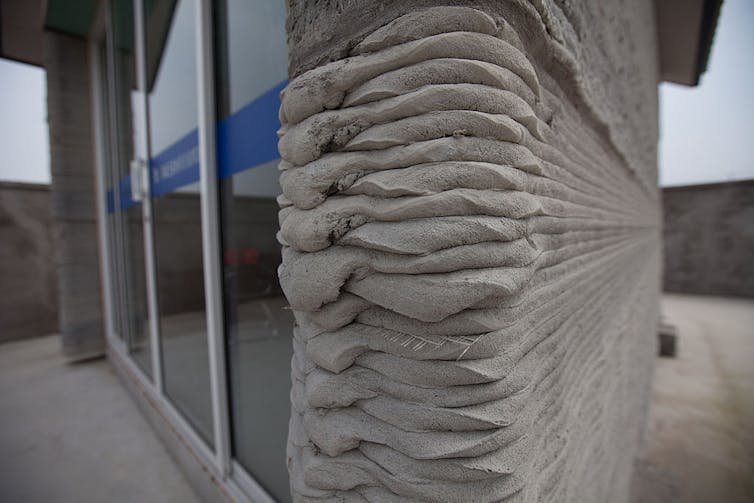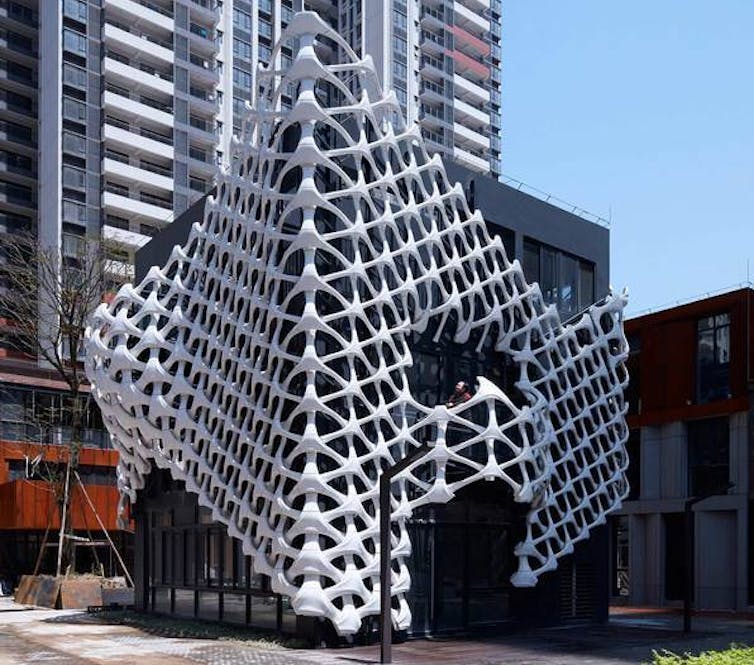James Rose University of Tennessee – In architecture, new materials rarely emerge.
Concrete, masonry, and wood have been the mainstays of many structures throughout history.
The adoption of steel frames changed architecture forever in the 1880s. Steel enabled architects to design taller buildings and larger windows. This led to the creation of skyscrapers today.
Construction materials have remained largely limited to mass-produced components since the industrial revolution. This standardised set of parts has been used in the construction and design of buildings for over 150 year.
That may soon change with advances in what’s called “large-scale additive manufacturing.” Not since the adoption of the steel frame has there been a development with as much potential to transform the way buildings are conceived and constructed.
A large-scale additive manufacturing process, such as desktop 3D printers, involves the construction of objects one layer at time. Whether it’s clay, concrete or plastic, the print material is extruded in a fluid state and hardens into its final form.
As director of the Institute for Smart Structures at the University of Tennessee, I’ve been fortunate to work on a series of projects that deploy this new technology.
While there are still roadblocks that prevent widespread adoption, I can see the future when buildings are made entirely of recycled materials, or materials sourced locally, and with forms inspired from the geometries found in nature.
Promising prototypes
One of them is the Trillium Pavilion. It’s an open-air structure that was printed using recycled ABS polymer.
The structure’s thin, double-curved surfaces were inspired by the petals of its namesake flower. Students created the project and Loci Robotics printed them. The structure was built at Cherokee Farm, University of Tennessee in Knoxville.
Tecla is another example of large-scale additive manufacture. It is a prototype dwelling that measures 450 feet (41.8 meters) and was designed by Mario Cucinella architects. It was printed in Massa Lombarda in Italy.
Tecla was printed by the architects using clay from a nearby river. This unique combination of cheap material and radial geometry resulted in an energy-efficient alternative housing.
Back in the U.S., the architecture firm Lake Flato partnered with the construction technology firm ICON to print concrete exterior walls for a home dubbed “House Zero” in Austin, Texas.
This home measures 2,000 square feet (185.8 meters) and demonstrates 3D-printed concrete’s speed and efficiency. The structure also displays a striking contrast between its curvilinear walls, and its exposed timber frame.
Planning
Three knowledge areas are required for large-scale additive manufacturing: digital design, digital fabrication, and material science.
To start, architects create computer models that represent all the parts that will be printed. This software allows the designers to analyze how the components will perform under structural forces and adjust the components accordingly. These tools can help the designer reduce the weight of the components and automate certain design processes like smoothing complicated geometric intersections prior to printing.
Slicer software is a piece of software that converts the computer model to a set instructions for the printer.
You might assume 3D printers work at a relatively small scale – think cellphone cases and toothbrush holders.
3D printing technology has allowed hardware to scale up significantly. Sometimes the printing is done via what’s called a gantry-based system – a rectangular framework of sliding rails similar to a desktop 3D printer. Robotic arms are becoming more popular due to their ability print in any orientation.
The printing location can vary. While smaller parts and furnishings can be printed in factories for printing, entire houses must be printed on site.
For large-scale additive production, a wide range of materials are possible. Concrete is a very popular material due to its reliability and familiarity. Clay is an intriguing alternative because it can be harvested on-site – which is what the designers of Tecla did.
Plastics and polymers may have the greatest applications. These materials have a lot of versatility and can be tailored to suit a wide variety of aesthetic and structural requirements. These materials can also be made from organically and recycled materials.
Inspiration from nature
Because additive manufacturing builds layer by layer, using only the material and energy required to make a particular component, it’s a far more efficient building process than “subtractive methods,” which involve cutting away excess material – think milling a wood beam out of a tree.
Even common materials like concrete and plastics benefit from being 3D-printed, since there’s no need for additional formwork or molds.
Most construction materials are mass produced today on production lines that are intended to produce the exact same components. This process reduces cost but leaves little room to customize.
Large-scale additive manufacturing eliminates the need for tools, forms, or dies. This allows each part to be uniquely created without any time penalties for additional complexity or customization.
A further advantage of large-scale additive production is the ability to produce complex parts with internal voids. This will allow walls to be printed using conduit or ductwork that is already in place.
In addition, research is taking place to explore the possibilities of multi-material 3D printing, a technique that could allow windows, insulation, structural reinforcement – even wiring – to be fully integrated into a single printed component.
I find it fascinating that additive manufacturing, which is based on a slow hardening material, allows you to build layers layer by layer. This mirrors natural processes like shell formation.

This creates opportunities for designers to design geometries that are hard to achieve using other construction methods but common in nature.
A lightweight lattice of tubes could be made using structural frames inspired by bird bone’s fine structure. Façades that evoke the shapes of plant leaves might be designed to simultaneously shade the building and produce solar power.
Learn from your mistakes
There are many obstacles to large-scale additive manufacturing’s wider adoption despite its many positive attributes.
The biggest challenge is its novelty. It is a complex infrastructure that revolves around traditional methods of construction such as steel, concrete, and wood. These include supply chains, building codes, and even building codes. The cost of digital fabrication hardware can be quite expensive, and it is not easy to learn the design skills required to work with these materials.
3D printing architecture needs to find its niche in order to be more widely accepted. Like word processing, I believe it will be large-scale additive manufacturing which will make it more popular.
Its ability to produce highly efficient structural frames may be what it is. I also already see its promise for creating unique sculptural façades that can be recycled and reprinted at the end of their useful life.
Whatever the case, it is likely that some combination factors will ensure that future buildings are 3D-printed.

James Rose, Director at the Institute for Smart Structures University of Tennessee
This article was republished by The Conversation under Creative Commons. The original article is available here.



